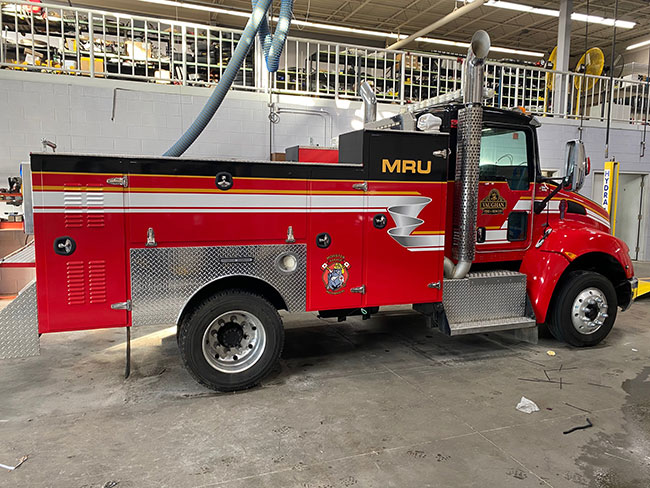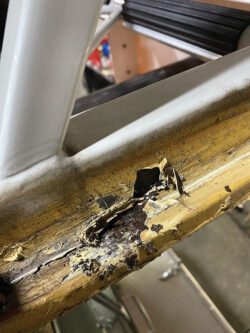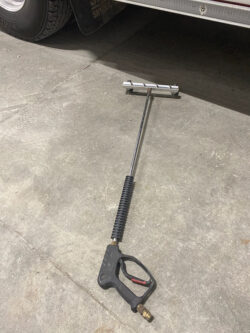
Features
Spring truck clean up: Going deep
May 3, 2023
By Chris Dennis
 A full vehicle wrap job is less expensive than paint and the image can be changed easily.
ALL PhotoS: Chris Dennis
A full vehicle wrap job is less expensive than paint and the image can be changed easily.
ALL PhotoS: Chris Dennis Spring has arrived! Hopefully everyone is healthy and safe and adjusting to the new post-covid world order, though some things never change, like the fact that spring is the time to have your apparatus well looked over. If you require an annual safety inspection in your province, and it is not due, spring is still the best time to go deep.
Winter has been hard in many places this year, but not so much in others, but everywhere de-icing programs have now subsided until the fall. Winter road salt, sand and plain old dirt has migrated far into the bodies and chassis. What we don’t see won’t hurt us, right? This is the farthest thing from the truth. Most de-icing agents go on as a liquid when applied to the roadways and usually before the onset of ice and snow. When the bad weather comes, it activates the de-icing agents and puts them to work. This is an effective measure. It is environmentally stable in most cases and works safely to keep ice off the roads. However, like its road application, once it sprays up into the chassis of the trucks and apparatus it will flow into every nook and cranny and then dry. Once it dries it lays dormant until the next time it gets wet. Now it won’t be ice or snow, but a spring or summer shower. The water will splash up into the body and chassis, flow into those nooks and crannies, and activate this now highly corrosive cocktail. In these confined areas, the corrosion spreads and is well protected to continue to eat away at steel and aluminum. It eats wiring connectors and worst of all, if left undetected, begins the process of destroying cross members and causing frame damage.
An aerial truck or platform sits exposed on top of the trucks (I am referring to a hydraulically driven aerial, be it aluminum or steel). The de-icing agent runs into and down the beams under the rubber rung steps and under foot holds, stokes basket and pike pole holders. It is out of sight and out of mind. A paint chip is all it takes for this liquid corrosion to get under the paint and begin eating the metal material the paint was protecting. By the time you see the paint lifting, the corrosion process has already removed metal material, making it brittle or no longer suitable to perform the task it was designed to do as its integrity, rigidity, and strength has now been degraded by its erosion.
I recall a time that a steel painted refurbished ladder needed to be sent back to the manufacturer, where it was completely disassembled and rebuilt like new with thr latest technology and certifications, and then repainted. I brought in a third party to perform structural measurements and a thickness test. It didn’t seem like it would pass, but it was well within limits for a long time to come. The area was treated, primed and painted with POR 15 paint. Then colour matched once dried.
Another story: roll up doors that appear to have been hit with a machine gun. Random raised spots all over. The door lats were corroding from the inside out. These are not things you want to see.
THE BIG SPRING CLEAN
For your going deep spring clean, empty the compartments using a debrining or salt eliminating solution that is not caustic and is environmentally friendly. Wash out each compartment thoroughly. If electrics are present, use caution and care. If unsure, then speak to a technician prior to wetting down the area in question. Once clean, a clear silicone base spray-on product can be used as a sealer. It’s not a forever thing but works from season to season. We use a product that protects rubber as well, it won’t let it dry out and dirt and grime won’t stick.

Undetected corrosion can be overlooked. Aerial cleaning annually will detect this before it becomes more costly.
Use an under-wash vehicle system (we got one off Amazon, of all places). It clips onto the pressure washer and has wheels and jets. Roll this under the rig using a debrining agent. Super soak the underside. This part may seem crazy: Take it for a drive with the debrining solution. It will blow back into the areas you can’t spray and will begin working on the stuff you can’t see. Do this a few times over the warmer months so that when fall comes you can rust proof this rig and it too will slip into the hard to get spots and protect it for the winter.
We lift the truck to spray down and debrine entirely under the chassis. We have lifts for this. If you don’t, your truck repair shop should. Let this soak as per manufacturer instructions. Then every nut and bolt we can see or can get a wrench on, is torqued and then head painted to monitor if it moves. This way we can see throughout the year if a bolt is missing or has loosened off. This has happened purely because of rust. We then rinse it off, let it dry and send it out for rust proofing, in our case. The program is time consuming as the truck is out of service for three days alone. The result is preventative maintenance and a warning device of something happening, as well as serving the purpose of inspecting things and areas you take for granted (things that go bad and cost large amounts of money or result in catastrophic failure).
Ladders need washing, degreasing and lubrication. Spring is the time. A crew of four can have this done with a multi-fly ladder or platform in four to six hours. Single fly ladders take a few hours. To save your investment, a time investment or large financial investment must be made. Keep aluminum and steel ladders clean and lubricated as per manufacturer guidelines and they will last.
One challenge might be getting the firefighter of this generation motivated to do more with the trucks. The firefighter of today could be more of an academic, but there is something to be said about being hands-on. Its like doing forcible entry or ventilation. Until you use the tools and get physical, it’s difficult to truly understand.

Use a pressure washer under vehicle spray nozzles. It is also useful to debrine and apply salt eliminator through the pressure washer on underside of the rigs.
At the height of covid I saw so many sanitation systems being used and up for sale: ultraviolet to kill air born germs, spray systems in cabs and station air purifiers. We were all so concerned for our well-being inside the rigs that we didn’t always consider the other side; the part where this truck needs to get you safely to the next call. If the trucks don’t run, you don’t get the job done. If your department has a dedicated apparatus repair division, you’re lucky. This is a costly division but keeps the rigs running 24 hours a day. Those that depend on the municipal or city fleet garage or an outside repair shop have some disadvantages, however, creating a deep clean program to be done in the spring and throughout the entire year (spring is the big one, then maybe every other month), will keep you ahead of the curve so these million-dollar rigs will last and look as good when they retire as the day they went into service.
If paint is an issue, have a hard look at a body wrap. We recently wrapped our service truck. Unfortunately, it sits outside most of the time. The paint had faded badly to the point where it looked orange. The truck was nowhere near ready to be retired but a fresh look would help. To paint the truck would take it out of service for three weeks, but to have it wrapped was only a week. We prepared the truck and had this job done. It looked like a new truck, which was a huge boost to the division and the floor. I have wrapped vehicles for the fire fleet in the past. For fire prevention we used education advertising. In operations, we used messages of praise and hope. Some were small wraps and some were full wraps. On average, the wraps lasted three to five years. The vinyls used today are much easier to remove as well. If the message changes, so does the look and that is a fresh, deep clean look. Wraps are not expensive, protect the truck, and allow the tax payers dollars to go further by keeping the equipment looking good and lasting longer.
The budgets you work on every year must include money to be invested purely in clean-up and corrosion avoidance. Include the cost of rust proofing a fire truck at your local rust protection facility. Ask them how much they will charge to debrine as well. This is better than nothing and will enable the fleet to last longer in our winters and possibly in your environment if corrosive materials are used to de-ice. You can buy bulk products that can be diluted and mixed and run through station power washers in the hall. Look into under chassis wash bars that go onto your power washer. If there is a municipal wash bay, look into a joint venture with the fleet department to add under chassis wash systems. I am sure city dump trucks, etc., can all use this type of deep clean.
This may not be all that technical, but it will surely assist with keeping the rigs we have looking grand, clean, and fit to run first to the finish safely every day. Remember my friends, rubber side down!
Chris Dennis is the chief mechanical officer for Vaughan Fire and Rescue Service in Ontario. He can be reached at Chris.Dennis@vaughan.ca.
Print this page
Advertisement
- Quebec flooding: Body of one of two missing volunteer firefighters found
- Quebec flooding: Bodies of firefighters found two days after being swept away